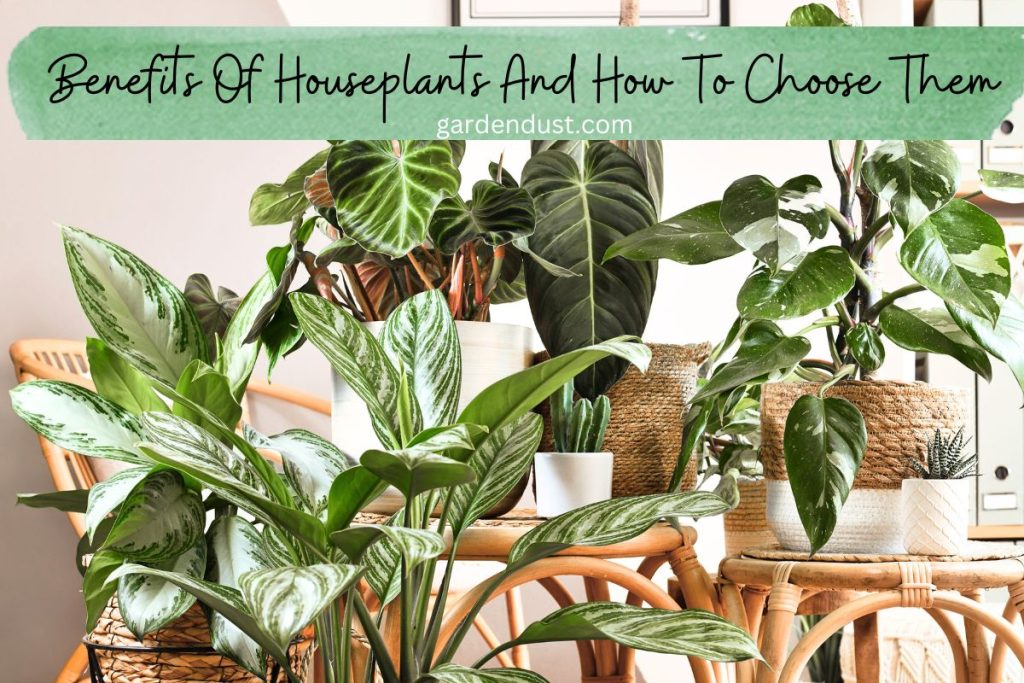In the hustle and bustle of modern life, creating a serene and healthy living space has become more crucial than ever. One simple yet effective way to enhance your home environment is by introducing houseplants. Beyond their aesthetic appeal, houseplants offer a myriad of benefits, ranging from improved air quality to stress reduction. In this article, we will explore the numerous advantages of having indoor green companions and delve into the benefits of houseplants and how to choose them. Let’s start…
Benefits of Houseplants-
I. Improved Indoor Air Quality
One of the primary benefits of incorporating houseplants into your home is the significant improvement in indoor air quality. Plants play a crucial role in purifying the air by absorbing pollutants and releasing oxygen through the process of photosynthesis. Common household toxins such as formaldehyde, benzene, and trichloroethylene are effectively filtered out by certain types of houseplants, promoting a healthier atmosphere for you and your family.
NASA’s Clean Air Study identified several plants, including the Spider Plant (Chlorophytum comosum), Snake Plant (Sansevieria trifasciata), and Peace Lily (Spathiphyllum spp.), as particularly efficient in removing indoor pollutants. By strategically placing these plants in different rooms, you can create a natural air purification system that contributes to your overall well-being.
II. Stress Reduction and Mental Well-being
The presence of houseplants has been linked to reduced stress levels and improved mental well-being. A study conducted by the University of Technology, Sydney, found that indoor plants can lower stress levels by up to 37%. The act of caring for plants and being surrounded by greenery has a calming effect, making indoor spaces more conducive to relaxation and focus.
Plants such as Lavender (Lavandula), Aloe Vera (Aloe barbadensis miller), and Jasmine (Jasminum) are known for their soothing aromas, further contributing to stress reduction. Placing these aromatic plants in bedrooms or areas where you unwind can create a tranquil environment, promoting better sleep and overall mental health.
III. Increased Productivity and Concentration
Houseplants don’t just benefit your physical and mental health; they also enhance your cognitive function and productivity. Research conducted by the University of Exeter shows that the presence of plants in workspaces can increase productivity by up to 15%. Plants help reduce fatigue, improve concentration, and create a more engaging and aesthetically pleasing environment.
When choosing houseplants for your workspace, consider low-maintenance options such as the ZZ Plant (Zamioculcas zamiifolia) or the Pothos (Epipremnum aureum). These plants thrive in a variety of conditions and require minimal attention, making them ideal companions for busy individuals seeking to boost their work efficiency.
READ ALSO:-Why Vertical Garden Is Important?
How to Choose the Perfect Houseplants
Selecting the right houseplants involves considering various factors such as light conditions, humidity levels, and your personal preferences. Here’s a comprehensive guide to help you choose the perfect green companions for your home:
· Assess Light Conditions:
Identify the natural light levels in each room. Some plants, like succulents and cacti, thrive in bright, direct sunlight, while others, such as ferns and snake plants, do well in lower light conditions.
· Consider Space and Size:
Take into account the available space and the size of the plants. Choose varieties that complement the size of your rooms and fit well on shelves, countertops, or larger floor spaces.
· Evaluate Maintenance Needs:
Be honest about the time and effort you can dedicate to plant care. If you’re a novice plant parent or have a busy schedule, opt for low-maintenance plants like the Spider Plant, Snake Plant, or ZZ Plant.
· Think About Air Quality Goals:
If improving indoor air quality is a top priority, choose plants known for their air-purifying capabilities, such as the Peace Lily, Boston Fern (Nephrolepis exaltata), or Rubber Plant (Ficus elastica).
· Consider Aesthetics and Personal Preferences:
Select plants that align with your personal taste and complement your home decor. Whether you prefer the sleek look of succulents or the lush foliage of tropical plants, there’s a wide variety to suit every style.
· Research Toxicity Levels:
If you have pets or small children, research the toxicity levels of potential houseplants. Opt for pet-friendly options like the Spider Plant, Areca Palm (Dypsis lutescens), or Boston Fern to ensure the safety of your loved ones.
· Combine Different Types:
Create a diverse indoor garden by combining different types of plants with varying shapes, sizes, and textures. This not only adds visual interest but also provides a more dynamic range of benefits.
· Consult Experts and Resources:
Seek advice from local nurseries, gardening experts, or online resources to learn more about specific plant varieties and their care requirements. Local experts can provide insights into plants that thrive in your specific climate and conditions.
Incorporating houseplants into your living space is a simple yet impactful way to enhance your overall well-being. From purifying the air to reducing stress and boosting productivity, the benefits of having indoor greenery are undeniable. By carefully selecting the right plants based on your space, preferences, and lifestyle, you can create an inviting and harmonious environment that nurtures both your physical and mental health. Embrace the green revolution and invite nature indoors — your home and your well-being will thank you. Happy Gardening…







